CHILDREN'S DAY (KODOMO NO HI)
or
TANGO NO SEKKU ( Æ[ī▀é╠É▀ŗÕ) or BOY'S FESTIVAL
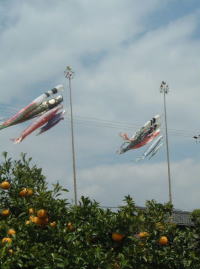 |
 |
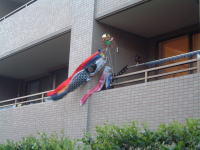 |
| KOINOBORI |
Iris or SHOBU |
KOINOBORI |
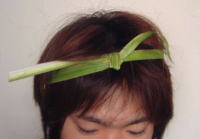 |
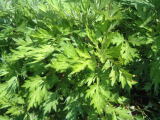 |
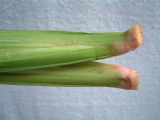 |
On May 5th, we float a bunch of
iris leaves in the bathtub..
When you come out from the
bath, wear an iris leaf around
your head |
MUGWORT |
the smell from red part keep
away you from bad illness or evil. |
May 5 is Chrildren's Day, a national holiday, for wishing all children's
happiness,
growth, good health and a wonderful future.
We also call this day 'TANGO NO SEKKU'.
TAN (Æ[üjmeans ' the first, start, beginning ' , and originally, in China
it meant
the first horseüiī▀üj day in May in Chinese callendar.
May is the horse month of the twelve signs of the Chinese zoiac.
As GO (ī▀üjhas the same pronunciation with üfī▄üiéTüjüf,
so it was made May 5 'TANGO- no -sekku'.
Tango-no-sekku is one of the 5 seasonal festivals in Japan.*
Sekku means seasonal festival.
In old China, they had had ceremony on each seasonal festival to drive
away evil spirits and wish
good health with medical herbs. Iris leaves are used on May 5.
.This custom was introduced to the court or nobleman in Nara or Heian period.
Later samurai follwed this custom.
Then, in the Edo period ( 1603- 1868) Tokugawa shogunate prescribed the
seasonal festivals.
The government decided that May 5 would be a festival, so the daimyos (lords)
wore formal kimonos,
and they had had to bring gifts to the Shogun.
After that, it got to use them when samurai had a male baby.
In this case, they would use a flag or a streamer in their place.
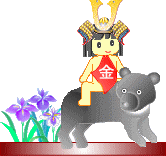
Iris is called SHOBUüiÅęŖŚüj in Japanese,
and we also have a word with the same pronunciation (Å«ĢÉüj the meanig
of
this is ' to put a high value on an armament or campaign or millitary arts.
So, this is the story of how May 5 become the Boy's Festival to honor boys.
(After the world war II we call it 'Kodomo no hi', Children's Day )
Traditionally, we had a custom
to put leaves of an Iris and mugwort under the eaves,
in order to clear the bad nature and to drive away evils spirits.
Back then May was thought to be a bad month, so women stayed
in the house and decorated the eaves with leaves of iris.and mugworts.
This was for purify women before rice planting.
So Japanese could combine the Chinese customs with this.naturaly.
| ć@ |
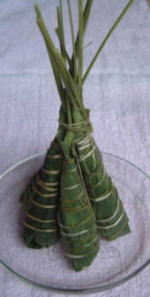 chimaki chimaki |
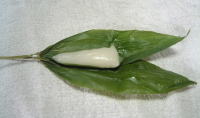 |
|
|
|
| Chimaki |
| ćA |
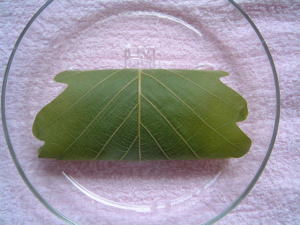 |
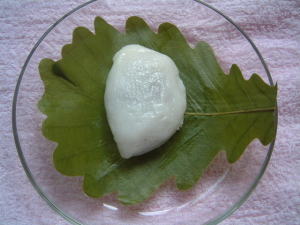 |
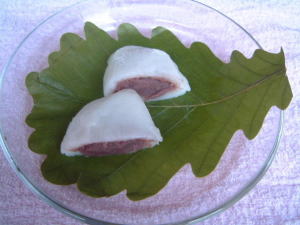 |
KASHIWA-MOCHI
Kashiwamochi is a rice cake
stuffed with sweet red bean paste and
wrapped in an oak leaf |
On Children's day, a room is decorated with warrior dolls, warrior's helmet
or armor.
And huge carp-shaped streamers hoisted on a long pole are displayed outdoors.
Recentry, lots of people live in apartments in a city,
it's impossible to display such huge streamers outside,
so they have very small size streamers.
Carp is a symbol of success, courage and power.
Because according to an old Chinese legend,
a carp which swam upstream to the waterfall
in Yellow River called "Ryumon" became a dragon.
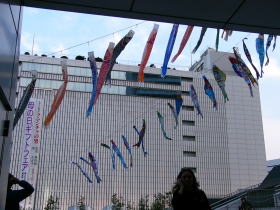 |
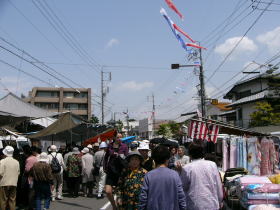 |
| Koinobori in front of Nagoya Station |
Koinobori at Kakuouzan |
This custome originated during the middle of the Edo period.
At that time, streamers or flags were only allowed to use by samurai, but
the people
really wanted to use them.
So they began usuing the carp-shaped streamers wishing a symbol of success.
On Childeren's Day, we have a custom to have a SHOUBU-YU or iris-leaves
bath.
In the hot water we put iris leaves and mugworts.
As mentioned previously, people have believed that they clean bad that
exists in nature with medicine.,
For example, while having a bath, parents put an iris leaf around the child's
head ,
or the child does it by themselves.
*January 7 (Jinjitsu-no-sekku as Nanakusa-no-sekku, Seven Herb Festival),
March 3 ( Johshi-no-sekku as Momo-no-sekku, Peach Festival),
May 5 ( Tango-no-sekku as Shobu-no-sekku, Iris Festival )
July 7 ( Tanabata Festival, Star Festival, The Galaxy Festival )
September 9 (Chouyou-no sekku as Kiku-no-sekku, Chrysanthemum Festival
)






 chimaki
chimaki




